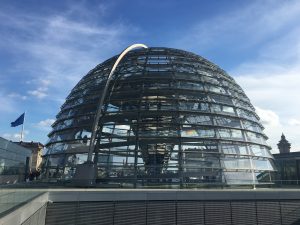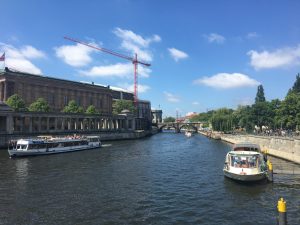We started the trip off with a long bus ride to Berlin from Krakow, and almost immediately went to visit the Bundestag. The actual building, the Reichstag, was last renovated in 1999, and I thought it was so cool that the architect, Norman Foster, decided to preserve the Soviet Union graffiti and bullet holes throughout the entire building; this added a lot of character to the building and was a nice tribute to the building’s history.
I also found it absolutely ingenious that the chambers were reconstructed every 4 years to match the number of delegates per number of seats in each party. The iconic dome on top also offered a nice 360 degree view of the city. I really enjoyed our tour of the Bundestag because I had known absolutely nothing about it, and it was a great way to get introduced to Berlin. While in Germany, we also visited the Cathedral, river walk, Museum of Terror and the German Historical Museum. A large group of us also ventured out to Prater Gärten, the oldest biergärten in Berlin. The atmosphere was very relaxed and calm, and I really enjoyed just spending time with the group underneath strings of lights, munching on hot pretzels, corn on the cob, and schnitzel.
As we visited each museum and exhibit, I was impressed that Germany made almost no excuses for their behavior during WW II. The nation owned up to their actions, both of the proactively violent SS soldiers and gestapos, and of the German citizens, who acted as bystanders and allowed the atrocities around them to exist with little resistance. Having just come from Auschwitz, I was nervous that the Germans would try to downplay the Holocaust and pin the blame on just Hitler, but the museums told the truth and didn’t sugarcoat or gloss over their unforgivable behavior.
On our last full day, we traveled to Potsdam and visited the Wannsee House, where the Wannsee Conference took place. The property itself was beautiful, and the surrounding lake and greenery were picturesque; it seemed like the perfect place to have a picnic. The house itself was also preserved nicely, and I could tell that it was an impressive building in its day. This beauty provided a stark contrast to the menacing and dark decisions that were made within the home’s walls. Just imagining that Hitler had walked in the same rooms as I was now strolling through, bringing even the most minute details of the Final Solution to fruition was very eerie, and in the end, took away from a lot of the charm the house would have otherwise had.
Our last meal and night out were very bittersweet. Every country we traveled to brought the group closer and closer, so by the time we made it to Berlin, we had become a family. I don’t think anyone was prepared for how well the group dynamic would work, or how much fun we would all have just playing cards or sitting around talking. There was never a dull moment and I could always count on someone to call out a funny inside joke on the bus or send a hilarious meme into the group message. Not only did I learn far more about World War II than I thought possible, but as I got to know everyone more and more, I realized that I was so lucky to be in the same group as so many talented, intelligent, and high achieving people. I know that the friendships I made on this trip will last as long as the memories, and I couldn’t be more grateful to have been a part of this experience.
























